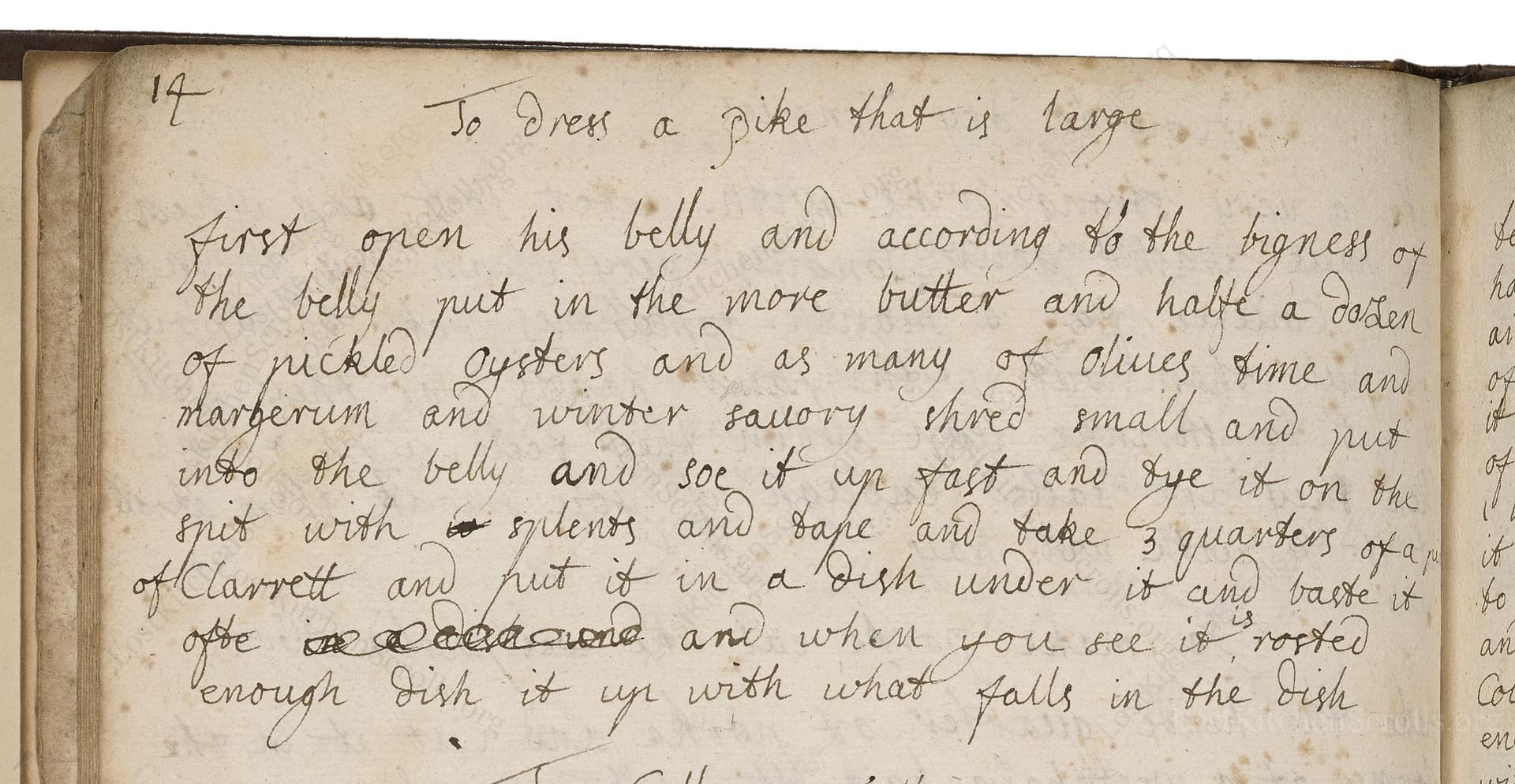To Dress A Pike That Is Large
From the treasured pages of Receipt book
Unknown Author

To Dress A Pike That Is Large
"First open his belly and according to the bigness of the belly put in the more butterr and halfe a dozen of pickled oysters and as many of olives time and marjerum and winter savory shred small and put into the belly and soe it up fast and tye it on the spit with splents and tape and take 3 quarters of a pint of Clarrett and put it in a dish under it and baste it ofte and when you see it is rosted enough dish it up with what falls in the dish"
Note on the Original Text
This early 18th-century recipe is written in a style typical of manuscript cookery—sparse in quantity details and reliant on the cook’s judgment. Ingredients are listed as they are used, with instructions embedded in a narrative form. Spellings are period-appropriate: 'Clarrett' for claret (red wine), 'soe' for sew, and 'tye' for tie. Recipes like this assumed the reader's kitchen skills and familiarity with local ingredients, leaving much interpretation to the cook—hence the charming vagueness and flexible measures.

Title
Receipt book (1700)
You can also click the book image above to peruse the original tome
Writer
Unknown
Era
1700
Publisher
Unknown
Background
A delightful glimpse into the kitchens of the early 18th century, this historic culinary manuscript promises a feast of recipes, remedies, and perhaps a pinch of mystery. Expect both practical fare and elegant inspiration for the curious cook.
Kindly made available by
Folger Shakespeare Library
This recipe comes from around the year 1700, a time when English households with means often featured impressive fish dishes at their tables. Pike was a prized freshwater fish in early modern England, reserved for grander occasions due to its size and scarcity. The use of pickled oysters and olives, along with fragrant herbs, reflects the period's penchant for robust and contrasting flavors. Roasting over a spit with wine underneath would have produced an aromatic and succulent centerpiece fit for a celebratory meal.

The original method called for a roasting spit—commonly found in well-appointed kitchens of the 17th and 18th centuries—along with splents (thin wooden skewers), tape (linen or cotton bands for tying), and a needle and coarse thread to sew up the fish. The wine would have been collected in a shallow dish beneath the spit. In modern kitchens, a rotisserie or oven, roasting tray, kitchen twine, and an oven-proof pan easily replicate the historical approach.
Prep Time
20 mins
Cook Time
40 mins
Servings
6
We've done our best to adapt this historical recipe for modern kitchens, but some details may still need refinement. We warmly welcome feedback from fellow cooks and culinary historians — your insights support the entire community!
Ingredients
- 1 large pike (4.5–6.5 lbs, gutted and cleaned)
- 3.5–5 oz unsalted butter
- 6 pickled oysters (approx. 1.5 oz, or substitute with jarred pickled oysters)
- 6 green olives, pitted and chopped
- 1 tablespoon fresh thyme, chopped
- 1 tablespoon fresh marjoram, chopped
- 1 tablespoon fresh winter savory, chopped (or 1 1/2 teaspoons each fresh rosemary and sage as a substitute)
- kitchen twine (for sewing and tying)
- 1 2/3 cups red wine (preferably fruity claret/Bordeaux style)
Instructions
- Begin by cleaning and gutting a large pike (about 4.5–6.5 lbs).
- Fill the belly with approximately 3.5–5 oz of butter, 6 pickled oysters (or about 1.5 oz of modern jarred pickled oysters if fresh are unavailable), and 6 green olives (pitted and chopped).
- Add a tablespoon each of chopped fresh thyme, marjoram, and winter savory (if winter savory is not available, you can substitute with a mixture of rosemary and sage).
- Sew up the belly securely with kitchen twine, then tie the pike to a roasting spit or secure firmly on a modern rotisserie using twine or heat-safe bands.
- Place a roasting tray with 1 2/3 cups of red wine (preferably a fruity and medium-bodied claret or Bordeaux-style wine) underneath to catch the drippings.
- Roast, basting frequently with the wine, until the fish is just cooked through (about 35-45 minutes at 350°F for a large pike).
- Serve the pike with the flavorful wine sauce from the pan poured over.
Estimated Calories
350 per serving
Cooking Estimates
It takes about 20 minutes to prepare the pike and stuffing, and around 40 minutes to roast it. Each serving has about 350 calories. This recipe makes 6 servings.
As noted above, we have made our best effort to translate and adapt this historical recipe for modern kitchens, taking into account ingredients nowadays, cooking techniques, measurements, and so on. However, historical recipes often contain assumptions that require interpretation.
We'd love for anyone to help improve these adaptations. Community contributions are highly welcome. If you have suggestions, corrections, or cooking tips based on your experience with this recipe, please share them below.
Join the Discussion
Rate This Recipe
Dietary Preference
Main Ingredients
Culinary Technique
Occasions

Den Bockfisch In Einer Fleisch Suppen Zu Kochen
This recipe hails from a German manuscript cookbook compiled in 1696, a time whe...

Die Grieß Nudlen Zumachen
This recipe comes from a rather mysterious manuscript cookbook, penned anonymous...

Ein Boudain
This recipe comes from an anonymous German-language manuscript cookbook from 169...

Ein Gesaltzen Citroni
This recipe, dating from 1696, comes from an extensive anonymous German cookbook...
Browse our complete collection of time-honored recipes



